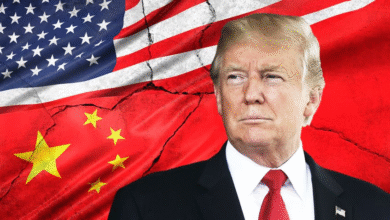Stellantis New CEO Antonio Filosa Takes Leadership Role

In a pivotal moment for Stellantis, the automotive powerhouse has appointed Antonio Filosa as its new CEO, marking a significant change in leadership during challenging times for the automotive industry. Filosa, who previously served as the Chief Operating Officer for North America, steps into this high-profile role after the resignation of Carlos Tavares and is set to officially assume his duties on June 23. This decision comes as Stellantis grapples with a 14% drop in net revenues and the complexities of shifting trade policies, making it a crucial time for automotive companies. Filosa’s extensive 25 years of experience within the organization, including leadership roles at Jeep and as Chief Quality Officer, position him uniquely to navigate these turbulent waters. As Stellantis moves forward under his guidance, many in the automotive industry will be keenly observing the impact of this CEO appointment on the company’s trajectory and overall market performance.
The recent elevation of Antonio Filosa to the helm of Stellantis signals a significant shift in the strategic direction for this multinational automobile manufacturer. Following the unexpected departure of former CEO Carlos Tavares, Filosa’s appointment represents a critical juncture for the company’s growth and stability amidst fluctuating market conditions. Recognized for its diverse brand portfolio, Stellantis must now harness Filosa’s leadership skills to overcome pressing challenges, including declining sales and supply chain uncertainties. Insightful leadership in the global automotive market is essential, making this transition under Filosa’s vision particularly noteworthy. The response from industry stakeholders to this change will undoubtedly shape Stellantis’s future in the competitive landscape of automobile manufacturing.
Stellantis Names Antonio Filosa as New CEO
In a significant move for the automotive industry, Stellantis has officially appointed Antonio Filosa as its new Chief Executive Officer, replacing Carlos Tavares who resigned under challenging circumstances. This decision follows an extensive search for leadership that has drawn attention across the global auto market. As COO of North America, Filosa brings a wealth of experience, having worked with various well-established automobile companies, including Jeep and Fiat, for over 25 years. His appointment is expected to steer Stellantis towards recovery and innovation, especially after a troubling fiscal quarter.
Filosa’s leadership comes at a time when the automotive sector is grappling with various challenges, such as declining sales and rising operational costs. His position is particularly pivotal as Stellantis navigates uncertainties related to trade policies that can impact vehicle pricing and supply chains. With a focus on revitalizing the brand portfolio, including Jeep, Dodge, and Chrysler, Filosa is tasked with not only reinstating profitability but also enhancing brand loyalty among consumers.
Challenges Ahead for Stellantis Under New Leadership
Stellantis faces several hurdles as Antonio Filosa steps into his role as CEO. The recently reported 14% decline in first-quarter net revenues underscores the urgent need for strategic reforms within the company. Filosa will have to address issues related to production efficiency and market competitiveness in an environment significantly altered by global trade dynamics. The fluctuations in trade tariffs, which have caused uncertainties in supply chains, demand immediate attention to ensure the corporation remains resilient amidst these volatile situations.
In this challenging climate, Filosa’s previous roles in quality and operations offer hope for a robust turnaround strategy. He can leverage his intimate knowledge of Stellantis’s operations and spearhead initiatives that focus on improving the customer experience while removing inefficiencies from the production line. As the CEO seeks to align Stellantis with sustainable practices, advancements in electric vehicle technology and adherence to regulatory standards will likely become a focal point for the company.
Implications of Antonio Filosa’s Appointment on Share Prices
The appointment of Antonio Filosa as the new CEO is anticipated to influence the stock market’s perception of Stellantis. Struggling shares, which have seen a nearly 27% decline year-to-date on the Milan stock exchange, could experience fluctuations as investors react to Filosa’s strategic vision and immediate plans. As industry news breaks surrounding his initiatives to stabilize finances and improve operational capacity, market analysts are keenly observing the company’s trajectory.
Investor confidence will largely depend on Filosa’s ability to outline a clear recovery strategy and communicate effectively with shareholders. By implementing transparency and engaging in proactive strategies, Filosa could potentially restore faith in Stellantis’s long-term growth prospects. Attention will be on upcoming shareholder meetings where both financial transparency and strategic direction will be key discussion points, helping to clarify how the new leadership aims to overcome prior setbacks.
Antonio Filosa’s Vision for Stellantis at a Critical Juncture
Antonio Filosa’s entry into the role of chief executive comes at a critical juncture for Stellantis, as the automotive landscape evolves rapidly towards electrification and technological advancements. In his inaugural remarks, Filosa emphasized his commitment to reinforcing Stellantis’s dedication to innovation. His extensive experience with the Jeep brand lends credibility to his vision of expanding electric models while retaining the essence of Stellantis’s diverse portfolio, which has historically included iconic brands.
To successfully navigate this transformative era, Filosa plans to collaborate closely with the executive team and board members to assess the operational pitfalls that have plagued the company. Drawing from his experiences in leadership and quality management, he aims to unify the workforce around common goals, ensuring that every team member is aligned with the company’s objectives. This strategic alignment will be essential in fostering a culture of accountability, trust, and sustainable growth.
The Future of Stellantis: Insights from Executive Chairman John Elkann
John Elkann, who has been interim chairman since Carlos Tavares’s departure, remains optimistic about the future of Stellantis under Antonio Filosa’s leadership. Elkann clearly articulated Filosa’s deep understanding of Stellantis’s core strengths, arguing that his knowledge of the workforce and the marketplace is invaluable during a time of transformation. His support portrays a united front that is crucial as Stellantis endeavors to overcome the recent setbacks and improve overall operational effectiveness.
Elkann’s endorsement not only showcases Filosa’s qualifications but also highlights the board’s collective confidence in a fresh leadership approach. Future initiatives will likely focus on rebuilding brand integrity, improving customer relationships, and investing in groundbreaking technologies that align with evolving consumer expectations. The collaborative efforts between Filosa and the executive team will be instrumental in driving Stellantis’s recovery in the marketplace.
Antonio Filosa’s Prior Experience Positions Him Well for the CEO Role
Antonio Filosa’s extensive background in the automotive industry uniquely positions him to undertake the role of CEO at Stellantis effectively. His previous positions, including being the head of Jeep and COO for North America, have provided him with a comprehensive view of the intricacies involved in delivering a successful automotive strategy. His familiarity with internal operations and external market pressures equips him to make informed decisions that could lead Stellantis back to a path of profitability.
Moreover, Filosa’s approach towards prioritizing quality and innovation will be vital as Stellantis seeks to revive its product lines and enhance consumer trust. Understanding the expectations of a modern automotive customer allows him to align Stellantis’s offerings with current market demands, such as sustainability and cutting-edge technology. This alignment can help mitigate the effects of past declines and pave the way for a future marked by growth and competitive advantage.
Navigating Trade Policy Challenges as New CEO
The global automotive industry is at the mercy of fluctuating trade policies, a reality that falls on Antonio Filosa’s shoulders as he steps into the CEO role. The unpredictable nature of tariffs has created significant challenges for companies like Stellantis, which relies heavily on cross-border manufacturing and supply chains. Filosa’s immediate task will be to assess how these policy changes affect Stellantis’s operational capabilities and devise strategies to mitigate potential impacts.
Engaging in proactive dialogues with policymakers and establishing strong lobbying efforts could be essential under Filosa’s leadership. His commitment to understanding both the complexities of the automotive market and the legislative environment will help Stellantis adapt to changes and maintain a competitive edge. The focus will likely be on finding cost-effective solutions that ensure continued product delivery and customer satisfaction despite external pressures.
Plans for Revitalizing Stellantis’s Brand Portfolio
Revitalization of Stellantis’s brand portfolio is a central priority for new CEO Antonio Filosa. His extensive experience with high-performance brands like Jeep equips him with the insights needed to enhance market positioning across Stellantis’s diverse offerings. This entails not just focusing on traditional automobiles but embracing innovative electric vehicle models that resonate with forward-minded consumers, especially in North America where environmental concerns are becoming more prevalent.
In revitalizing the brands, Filosa aims to foster a cohesive brand identity that leverages the heritage and strengths of each name under the Stellantis umbrella. By intertwining increased consumer engagement with technological advancements, the company seeks to bolster sales and brand loyalty going forward. This strategic emphasis on brand revitalization underlines a commitment to remaining relevant in a rapidly changing automotive landscape.
Stellantis’s Strategic Vision in the Face of Industry Challenges
As CEO, Antonio Filosa faces the challenge of developing a strategic vision that aligns with both market expectations and the corporate goals of Stellantis. The automotive industry is undergoing transformative change, with trends leaning towards sustainable practices, electric vehicles, and digital innovation. Addressing these imperatives is critical for Stellantis to maintain relevance in a competitive sector, and Filosa’s leadership will be pivotal in driving these changes from conception to execution.
In his role, Filosa must navigate the complexities of consumer preferences, regulatory demands, and technological advancements that define today’s automotive environment. By fostering an adaptable strategic vision, he can empower Stellantis to not only recover from current obstacles but also flourish as an industry leader. This visionary leadership will require collaboration across all levels of the organization, ensuring unity and purpose as the company embarks on this new trajectory.
Frequently Asked Questions
Who is the new CEO of Stellantis and what is his background?
Antonio Filosa has been appointed as the new CEO of Stellantis, taking over from Carlos Tavares. A veteran of the company with over 25 years of experience, he previously served as the CEO of the Jeep brand and more recently as Chief Operating Officer for North America. Filosa’s extensive experience in the automotive industry positions him well to lead Stellantis during a crucial time for the company.
What challenges did Stellantis face leading to the CEO appointment of Antonio Filosa?
Stellantis encountered significant challenges, including a drop in profits and declining sales, which prompted the unexpected resignation of former CEO Carlos Tavares. The company also reported a 14% decrease in net revenues and decided to withdraw its full-year financial guidance due to uncertainties linked to U.S. trade policies, significantly impacting the automotive sector.
What will be Antonio Filosa’s responsibilities as CEO of Stellantis?
As the new CEO of Stellantis, Antonio Filosa will oversee the company’s strategic direction and operations globally, focusing on addressing the current challenges in the automotive industry, revitalizing sales, and improving profitability. He officially starts his duties on June 23, after being appointed during a critical transitional period for Stellantis.
What did John Elkann say about Antonio Filosa’s appointment as Stellantis CEO?
John Elkann, the executive chairman of Stellantis, expressed confidence in Antonio Filosa’s appointment by stating that Filosa’s deep understanding of Stellantis and its people makes him ideally suited for leading the company through its next critical phase. Elkann emphasized the importance of Filosa’s experience in the automotive industry and his capability to drive Stellantis forward.
What impact might Antonio Filosa’s leadership have on Stellantis amid current automotive industry challenges?
Under Antonio Filosa’s leadership, Stellantis may encounter an opportunity to stabilize its operations and tackle the challenges stemming from profit declines and sales issues. His extensive experience in the auto sector and familiarity with Stellantis’s culture may help in steering the company towards recovery and growth amid uncertain market conditions.
Why did Stellantis’s shares decline nearly 27% year-to-date prior to the appointment of Antonio Filosa?
Stellantis shares faced a nearly 27% decline year-to-date primarily due to the company’s reported profit drop, declining sales, and the broader uncertainties associated with fluctuating U.S. trade policies. These factors, compounded by the resignation of former CEO Carlos Tavares, contributed to investor concerns regarding the company’s future performance and leadership.
What brands does Stellantis oversee that are crucial for its market presence?
Stellantis oversees a diverse portfolio of well-known automobile brands, including Jeep, Dodge, Fiat, Chrysler, and Peugeot. These brands are integral to Stellantis’s market presence and revenue generation within the competitive automotive industry.
What is the significance of Antonio Filosa’s appointment as CEO of Stellantis for the automotive industry?
Antonio Filosa’s appointment as CEO of Stellantis is significant as it underscores a leadership change during a pivotal phase for both the company and the automotive industry. His experience and vision will be crucial as Stellantis navigates current challenges, adapting to market demands and evolving customer preferences in a highly competitive landscape.
| Key Point | Details |
|---|---|
| Appointment of New CEO | Antonio Filosa, previously COO for North America, has been appointed as CEO. |
| Extraordinary Shareholder Meeting | An extraordinary meeting will be held soon to elect Filosa to the board. |
| Beginning of CEO Duties | Filosa will officially take over the CEO role on June 23. |
| Background of CEO | Filosa has 25 years of experience, including roles as CEO of the Jeep brand. |
| Succession Planning | Filosa succeeds Carlos Tavares, who resigned after a profit drop. |
| Financial Challenges | Stellantis reported a 14% revenue decrease and has withdrawn full-year guidance. |
| Impact of Trade Policies | Uncertainties regarding trade tariffs are affecting the automotive sector. |
| Current Executive Oversight | John Elkann is overseeing the executive committee until Filosa’s official start. |
| Stock Performance | Stellantis shares have declined nearly 27% year-to-date. |
Summary
Stellantis’ new CEO, Antonio Filosa, takes the helm at a time when the company faces significant challenges, including declining revenues and evolving market conditions. With a strong background in the automotive industry, Filosa is well-positioned to navigate these complexities and lead Stellantis through this pivotal phase. His appointment is not just a transition in leadership but a crucial step towards revitalizing the company and ensuring sustained growth in the changing landscape of the automotive sector.




